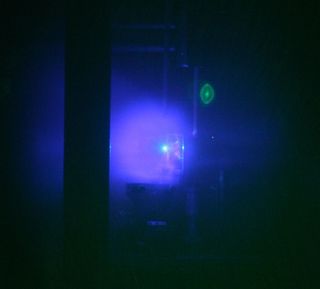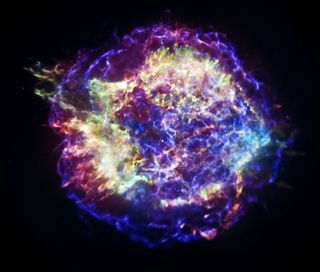Boom! Enormous Supernova Explosion Created in the Lab

An enormous explosion, rivaling the most powerful outbursts in the universe, called a supernova, has been created in a lab, along with the associated shock wave of charged particles, scientists report.
The scientists from the University of Oxford weren't just looking to blow things up. Led by Gianluca Gregori and graduate student Jena Meinecke, the team wanted to know why the magnetic fields in Cassiopeia A, the remains of a star that exploded in a supernova, are intense and uneven in some places, taking on odd shapes. The experiment could also shed light on why magnetic fields in intergalactic space are a million billion times stronger than theory predicts.
Current theories say that the measured fields in interstellar space should be about 10-21 Gauss, with the Gauss being a unit of magnetic field strength. (Earth's magnetic field varies from 0.25 to 0.65 Gauss, depending on where you are).
The uniformity is because when Earthlings look deep into space, they see the cosmic background radiation, which is a microwave signal that's an echo of the Big Bang that began the whole universe. That background radiation looks pretty much the same everywhere. [Big Bang to Civilization: 10 Amazing Origin Events]
"It's very smooth, very uniform," Gregori told Live Science. The smoothness means the space between stars doesn't produce much electric charge, leading to a very weak — and uniform — magnetic field in that space.
The actual value of that charge is a million billion times stronger than what the theory says it should be. "We have this idea that whatever produced that [background] field has been amplified."
Blowing up carbon
Sign up for the Live Science daily newsletter now
Get the world’s most fascinating discoveries delivered straight to your inbox.
To help answer the question of why the universe's magnetic field is so strong, the researchers put a rod of carbon about 500 microns (just under one-50th of an inch) into a chamber filled with argon, an inert gas at low pressure. Near the carbon, they placed a plastic grid, which served as a barrier to simulate the interstellar medium.

Then they fired a powerful laser beam at the carbon. When the beam hit the rod, the carbon vaporized. A shock wave of plasma — charged particles — expanded from where the carbon was. The blast would've looked like a very quick flash of light, if viewed with a high-speed camera, as the high power laser means one shouldn't look at the light directly with unprotected eyes. There was so much energy in the plasma that it mimicked a supernova, except instead of blasting out over light years and taking months to brighten and die out, the whole thing was over in a fraction of a second. [Supernova Photos: Great Images of Star Explosions]
The shock wave didn't expand outward uniformly. Instead, it hit the plastic grid and turned into a turbulent, or rough, flow, with lots of eddies and lumps. Any moving charged particle creates a magnetic field, and the ones in the chamber looked a lot like those in Cassiopeia A, with areas that were more intense and uneven than other regions. The researchers ran the same experiment without the barrier, finding the plasma expanded in a much more uniform way, producing much weaker magnetic fields.
When a star like the one that created Cassiopeia A explodes, the material pushes out into the interstellar medium. That medium isn't perfectly smooth, as there are areas that are more and less dense. Even though it may seem like the space between stars is empty, anywhere from about 100 atoms per cubic meter to a trillion in the same volume pervade that space. Anything less than 100 million atoms per cubic meter is still a better vacuum than can be produced on Earth.
Yet even that rarefied gas adds up over millions of miles. And when the shock wave from an exploding star hits regions where the interstellar medium is a bit denser, the charged particles cause more intense magnetic fields within these turbulent areas.
Solving a supernova mystery?
Because the vortices within the turbulent flow that his team measured in the experiment — and by extension, the ones generated in supernovas — seem to intensify magnetic fields, they could explain why the measured fields in space are as strong as they are.
Gregori is cautious about some aspects of the work, though. While he was able to generate something that looks similar to the real world in the lab, some aspects of magnetic field behavior aren't perfectly scalable. That is, making a miniature model may not tell you everything about the system it is supposed to simulate.
The work did, however, show that models assuming supernovas expand into a uniform interstellar medium are probably inaccurate, and that the stronger-than-expected magnetic fields in space are the result of its lumpy, uneven nature.
Follow us @livescience, Facebook & Google+. Original article on Live Science.
